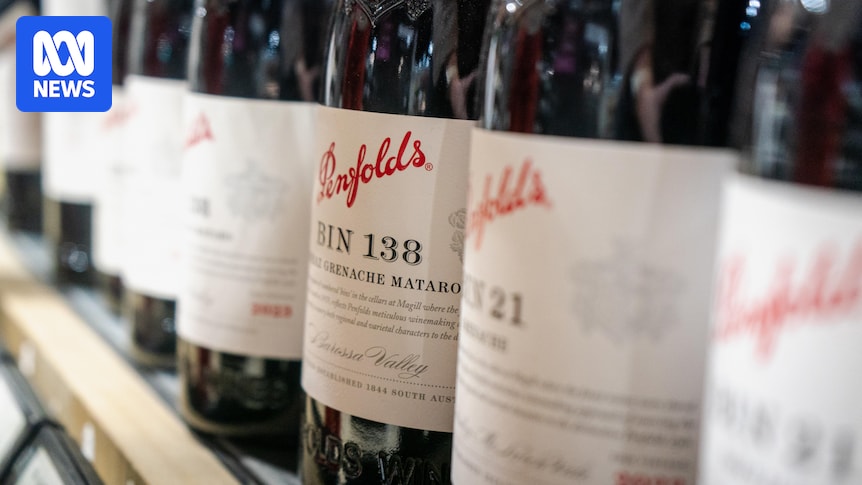China appears to no longer be the golden goose it once was for Australian wine exports, as demand slackens for even prestigious labels.
Penfolds owner Treasury Wine Estates (TWE) this week announced it would sell less of the luxury label in China than had previously been forecast.
It comes off the back of changing drinking habits and a reported crackdown on lavish banquets for civil servants.
Premium wines have in recent years been the best performers for Australian exports into the once-booming Chinese market, but changing economic conditions have taken their toll on the industry.
Wine Economics Research Centre executive director Kym Anderson said belt-tightening, health concerns and tariff wars had all hit the global wine trade.
Kym Anderson says it is hard to predict if and when the Chinese market will turn around. (Supplied: Kym Anderson)
“It’s true in lots of countries, not just China, that the uncertainty that Trump has introduced into global markets generally has reduced people’s confidence in both spending and investing, and in China that’s certainly the case,” Professor Anderson said.
He said the impact was now being felt “across the board”.
“Rich people also get hit when these times are less certain, so they’re probably reducing as well,” he said.
“In addition, during that period of COVID there was still a flood of imports [and] people were expecting consumption to keep growing rapidly, and it didn’t.
“So there were big stocks of wines, including premium wines, that were just sitting there needing to be cleared once the market opened up again, so that’s dampened growth in imports in recent times as well.”
While Australian producers of cheaper, bulk-produced wines have been battling other challenges, those making more premium label wines have still been largely enjoying good demand in key markets like China after the lifting of hefty tariffs on Australia wine post-COVID.
Some Australian premium wines will need to find new markets. (ABC South East SA: Elsie Adamo)
About 96 million litres of Australian wine worth more than $1billion was exported to China last financial year — a volume almost half of what it was at its peak in 2018.
Industry-wide impacts
Professor Anderson said it was another concern for the troubled wine industry that the top and bottom end of wines were being impacted.
“It’s affecting all different classes of wine,” he said.
“Iconic wines are the least worried I suppose, but the standard super-premiums and so on, as well as the low-end stuff, it seems is being affected now.”
In an announcement this week to the ASX, TWE said Penfolds sales in China softened in June and July, which it put down to changing consumer habits and less “large-scale banqueting occasions”.
Earlier this year global media outlets reported on new austerity regulations by Chinese officials targeting excessive drinking at banquets, which had affected alcohol sales within the country.
While it noted some uplift in the past two months, TWE said it no longer expected to reach its forecast Penfolds sales this year in China.
Penfolds is one of the premium brands affected by a downturn in demand from Chinese consumers. (ABC South East SA: Elsie Adamo)
Due to that and challenges with its distribution network in California, TWE paused an on-market share buy-back “until there is greater clarity around trading conditions and expectations”.
Industry ups and downs
Penfolds chief winemaker Peter Gago said cost-of-living challenges meant it was a tough time for wine, but it was part of the cycle of the industry.
“Everything’s about ebb and flow — it’s agriculture, so it’s all about cycles and you just have to broaden your base,” Mr Gago said.
“A nation of 1.4 billion people will also go through cycles.
“So yes, times are tough — a bit more difficult perhaps at the moment in a relative sense, but good times will come again and so it’s just a matter of hanging in there.”
It is not just the big players that are noticing dwindling demand for premium wines into China.
Patrick of Coonawarra received approval to send its wines into China once restrictions were lifted in 2024.
Luke Tocaciu says the business has been able to maintain a steady demand for its wine in China. (ABC South East SA: Elsie Adamo)
While demand started off strong, owner Luke Tocaciu said it had since become tougher to sell wine into China and his focus had turned to nations such as Indonesia and Canada.
“It’s not as in demand as it has been previously,” he said.
“We won’t be putting all of our export eggs in that basket — some of the emerging markets are certainly something I’m trying to get a foot in the door.”

